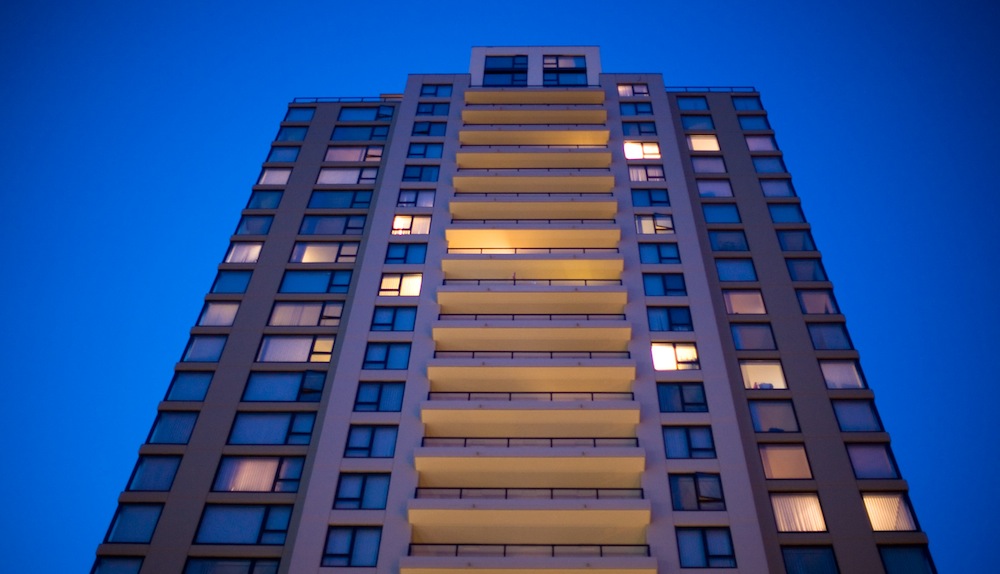A proposal to set lighting requirements for high-rise dwellings in the energy standard published by ASHRAE and the Illuminating Engineering Society (IES) is open for industry comment.
Fourteen addenda to ANSI/ASHRAE/IES Standard 90.1-2013, Energy Standard for Buildings Except Low-Rise Residential Buildings, are open for public comment from March 25 until April 24, 2016. Currently, lighting in dwelling units in high-rise buildings is exempt in both Standard 90.1 and ANSI/ASHRAE/IES Standard 90.2, Energy Standard for Low-Rise Residential Buildings.
“In general, lighting within someone’s personal dwelling unit (home) has been exempt because it was not considered commercial, which is the focus of 90.1,” said Eric Richman, chair of the standard’s lighting subcommittee. “Over time, the lack of dwelling unit requirements in 90.1 presented a potential gap in energy savings. These new requirements would set efficacy minimums and/or controls for the lighting in dwelling unit spaces covered in the standard’s scope, which includes multi-family structures of four stories or above.”
The proposed requirements are similar to those in the U.S. Environmental Protection Agency’s ENERGY STAR program for high efficacy lighting. The proposed efficacy requirements will effectively eliminate the use of incandescent/halogen sources as well as less efficacious products in the compact fluorescent (CFL) and light emitting diodes (LED) categories. To comment or learn more, visit here.
Related Stories
| Sep 21, 2010
New BOMA-Kingsley Report Shows Compression in Utilities and Total Operating Expenses
A new report from the Building Owners and Managers Association (BOMA) International and Kingsley Associates shows that property professionals are trimming building operating expenses to stay competitive in today’s challenging marketplace. The report, which analyzes data from BOMA International’s 2010 Experience Exchange Report® (EER), revealed a $0.09 (1.1 percent) decrease in total operating expenses for U.S. private-sector buildings during 2009.
| Sep 16, 2010
Green recreation/wellness center targets physical, environmental health
The 151,000-sf recreation and wellness center at California State University’s Sacramento campus, called the WELL (for “wellness, education, leisure, lifestyle”), has a fitness center, café, indoor track, gymnasium, racquetball courts, educational and counseling space, the largest rock climbing wall in the CSU system.
| Sep 13, 2010
Second Time Around
A Building Team preserves the historic facade of a Broadway theater en route to creating the first green playhouse on the Great White Way.
| Sep 13, 2010
Data Centers Keeping Energy, Security in Check
Power consumption for data centers doubled from 2000 and 2006, and it is anticipated to double again by 2011, making these mission-critical facilities the nation's largest commercial user of electric power. With major technology companies investing heavily in new data centers, it's no wonder Building Teams see these mission-critical facilities as a golden opportunity, and why they are working hard to keep energy costs at data centers in check.
| Aug 11, 2010
WattStopper contributes freezer case occupancy sensor to DOE study
WattStopper has participated in a ground-breaking demonstration of solid-state lighting (SSL) technology combined with occupancy sensors in grocery store freezer cases. The project was supported under the U.S. Department of Energy (DOE) Solid-State Lighting GATEWAY Technology Demonstration Program. WattStopper contributed FS-705 Wide Angle PIR occupancy sensors to the project.
| Aug 11, 2010
New data shows low construction prices may soon be coming to an end
New federal data released recently shows sharp increases in the prices of key construction materials like diesel, copper and brass mill shapes likely foreshadow future increases in construction costs, the Associated General Contractors of America said. The new November producer price index (PPI) report from the Bureau of Labor Statistics provide the strongest indication yet that construction prices are heading up, the association noted.
| Aug 11, 2010
29 Great Solutions for the AEC Industry
AEC firms are hotbeds of invention and innovation to meet client needs in today's highly competitive environment. The editors of Building Design+Construction are pleased to present 29 "Great Solutions" to some of the most complex problems and issues facing Building Teams today. Our solutions cover eight key areas: Design, BIM + IT, Collaboration, Healthcare, Products, Technology, Business Management, and Green Building.
| Aug 11, 2010
New Watt Stopper emergency relay panel
Watt Stopper/Legrand has developed a new relay panel to provide fail-safe emergency lighting in a variety of commercial settings. The Emergency Relay Panel option is UL924 listed for use on emergency circuits. It is available as an option with Watt Stopper’s 24 or 48 relay size Lighting Integrator (LI) low voltage lighting control panels.










